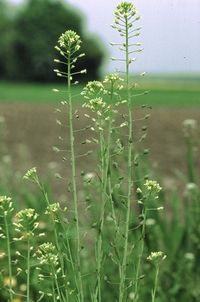
Photo from wikipedia
Abstract Premise Camelina (gold‐of‐pleasure or false flax) is an ancient oilseed crop with emerging applications in the production of sustainable, low‐input biofuels. Previous domestication hypotheses suggested a European or western… Click to show full abstract
Abstract Premise Camelina (gold‐of‐pleasure or false flax) is an ancient oilseed crop with emerging applications in the production of sustainable, low‐input biofuels. Previous domestication hypotheses suggested a European or western Asian origin, yet little genetic evidence has existed to assess the geographical origin for this crop, and archaeological data have not been systematically surveyed. Methods We utilized genotyping‐by‐sequencing of 185 accessions of C. sativa and its wild relatives to examine population structure within the crop species and its relationship to populations of its wild progenitor, C. microcarpa; cytotype variation was also assessed in both species. In a complementary analysis, we surveyed the archaeological literature to identify sites with archaeobotanical camelina remains and assess the timing and prevalence of usage across Europe and western Asia. Results The majority of C. microcarpa sampled in Europe and the United States belongs to a variant cytotype (2n = 38) with a distinct evolutionary origin from that of the crop lineage (2n = 40). Populations of C. microcarpa from Transcaucasia (South Caucasus) are most closely related to C. sativa based on cytotype and population structure; in combination with archaeological insights, these data refute prior hypotheses of a European domestication origin. Conclusions Our findings support a Caucasus, potentially Armenian, origin of C. sativa domestication. We cannot definitively determine whether C. sativa was intentionally targeted for domestication in its own right or instead arose secondarily through selection for agricultural traits in weedy C. sativa, as originally proposed by Vavilov for this species.
Journal Title: American Journal of Botany
Year Published: 2022
Link to full text (if available)
Share on Social Media: Sign Up to like & get
recommendations!